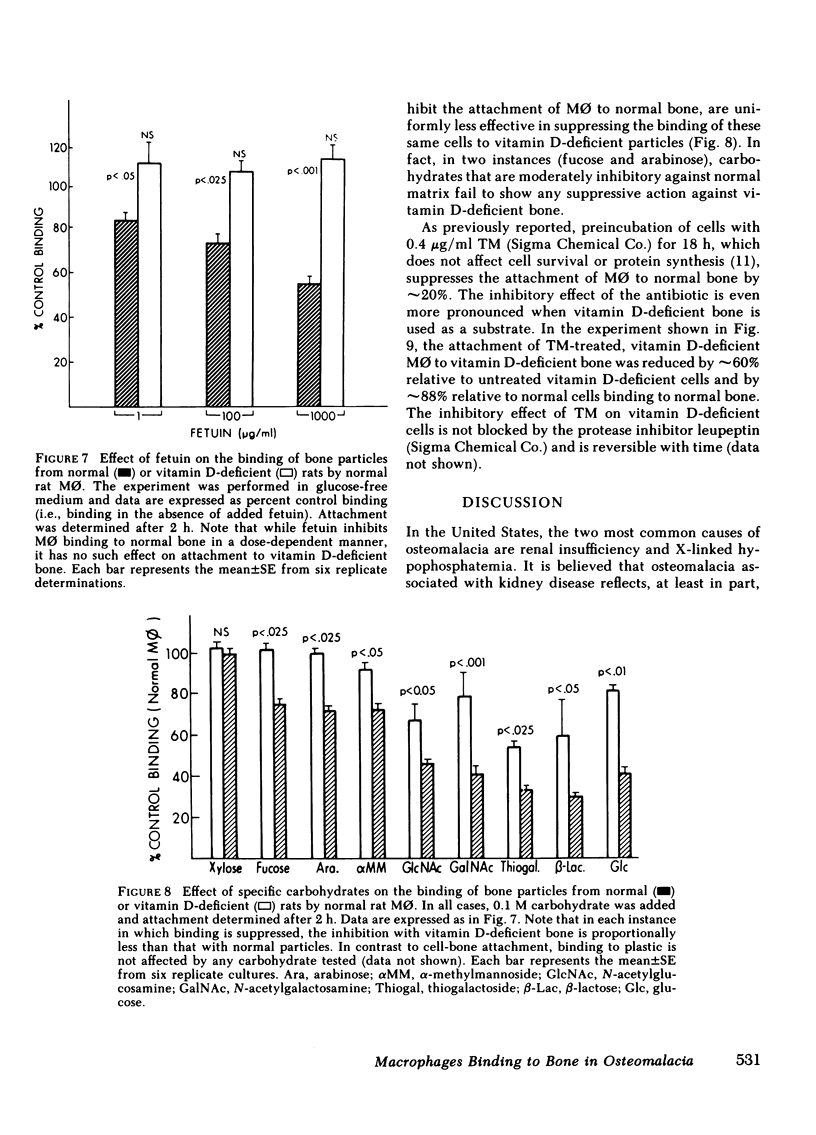Abstract
In the osteomalacic as well as normal skeleton, few osteoclasts are associated with osteoid-covered bone surfaces. The reason for this particular cellular deficit is not clear, but may relate to the inability of osteoclasts and/or osteoclast precursors (monocyte-macrophages) to attach to immature, unmineralized bone matrix, a step apparently essential for normal resorptive activity and osteoclast differentiation. In this study, we have examined cell-bone binding using macrophages (M phi) and bone isolated from vitamin D-deficient rats and hypophosphatemic, osteomalacic mice and from their normal counterparts. The data show that M phi-bone attachment is greatly reduced (P less than 0.001) in both vitamin D deficiency and hypophosphatemia, but that the mechanisms responsible for this reduction are apparently different in the two disorders. In hypophosphatemia, the reduction in binding appears solely attributable to the absence or inaccessibility of bone matrix oligosaccharides or glycoproteins essential to the attachment process. In vitamin D deficiency, on the other hand, not only is the bone matrix defective as a binding substrate, but the M phi, per se, is limited in its capacity to attach to normal, vitamin D-deficient, and hypophosphatemic bone.
Full text
PDF








Images in this article
Selected References
These references are in PubMed. This may not be the complete list of references from this article.
- BURNETT C. H., DENT C. E., HARPER C., WARLAND B. J. VITAMIN D-RESISTANT RICKETS. ANALYSIS OF TWENTY-FOUR PEDIGREES WITH HEREDITARY AND SPORADIC CASES. Am J Med. 1964 Feb;36:222–232. doi: 10.1016/0002-9343(64)90085-3. [DOI] [PubMed] [Google Scholar]
- Bar-Shavit Z., Noff D., Edelstein S., Meyer M., Shibolet S., Goldman R. 1,25-dihydroxyvitamin D3 and the regulation of macrophage function. Calcif Tissue Int. 1981;33(6):673–676. doi: 10.1007/BF02409507. [DOI] [PubMed] [Google Scholar]
- Bar-Shavit Z., Teitelbaum S. L., Kahn A. J. Saccharides mediate the attachment of rat macrophages to bone in vitro. J Clin Invest. 1983 Aug;72(2):516–525. doi: 10.1172/JCI110999. [DOI] [PMC free article] [PubMed] [Google Scholar]
- Bordier P. J., Marie P. J., Arnaud C. D. Evolution of renal osteodystrophy: correlation of bone histomorphometry and serum mineral and immunoreactive parathyroid hormone values before and after treatment with calcium carbonate or 25-hydroxycholecalciferol. Kidney Int Suppl. 1975 Jan;(2):102–112. [PubMed] [Google Scholar]
- Brumbaugh P. F., Haussler D. H., Bressler R., Haussler M. R. Radioreceptor assay for 1 alpha,25-dihydroxyvitamin D3. Science. 1974 Mar 15;183(4129):1089–1091. doi: 10.1126/science.183.4129.1089. [DOI] [PubMed] [Google Scholar]
- Burger E. H., Van der Meer J. W., van de Gevel J. S., Gribnau J. C., Thesingh G. W., van Furth R. In vitro formation of osteoclasts from long-term cultures of bone marrow mononuclear phagocytes. J Exp Med. 1982 Dec 1;156(6):1604–1614. doi: 10.1084/jem.156.6.1604. [DOI] [PMC free article] [PubMed] [Google Scholar]
- Eicher E. M., Southard J. L., Scriver C. R., Glorieux F. H. Hypophosphatemia: mouse model for human familial hypophosphatemic (vitamin D-resistant) rickets. Proc Natl Acad Sci U S A. 1976 Dec;73(12):4667–4671. doi: 10.1073/pnas.73.12.4667. [DOI] [PMC free article] [PubMed] [Google Scholar]
- Fraser D. R., Kodicek E. Unique biosynthesis by kidney of a biological active vitamin D metabolite. Nature. 1970 Nov 21;228(5273):764–766. doi: 10.1038/228764a0. [DOI] [PubMed] [Google Scholar]
- Glorieux F. H., Marie P. J., Pettifor J. M., Delvin E. E. Bone response to phosphate salts, ergocalciferol, and calcitriol in hypophosphatemic vitamin D-resistant rickets. N Engl J Med. 1980 Oct 30;303(18):1023–1031. doi: 10.1056/NEJM198010303031802. [DOI] [PubMed] [Google Scholar]
- Haddad J. G., Chyu K. J. Competitive protein-binding radioassay for 25-hydroxycholecalciferol. J Clin Endocrinol Metab. 1971 Dec;33(6):992–995. doi: 10.1210/jcem-33-6-992. [DOI] [PubMed] [Google Scholar]
- Holtrop M. E., King G. J. The ultrastructure of the osteoclast and its functional implications. Clin Orthop Relat Res. 1977 Mar-Apr;(123):177–196. [PubMed] [Google Scholar]
- Holtrop M. E., Raisz L. G. Comparison of the effects of 1,25-dihydroxycholecalciferol, prostaglandin E2, and osteoclast-activating factor with parathyroid hormone on the ultrastructure of osteoclasts in cultured long bones of fetal rats. Calcif Tissue Int. 1979;29(3):201–205. doi: 10.1007/BF02408081. [DOI] [PubMed] [Google Scholar]
- Hong K. C., Cruess R. L. Changes in organic matrix of bone and of bone and blood ATP in rats fed rachitogenic diets. Calcif Tissue Res. 1978 Aug 18;25(3):241–244. doi: 10.1007/BF02010776. [DOI] [PubMed] [Google Scholar]
- Jowsey J. Calcium release from the skeletons of rachitic puppies. J Clin Invest. 1972 Jan;51(1):9–15. doi: 10.1172/JCI106802. [DOI] [PMC free article] [PubMed] [Google Scholar]
- Kahn A. J., Malone J. D., Teitelbaum S. L. Osteoclast precursors, mononuclear phagocytes, and bone resorption. Trans Assoc Am Physicians. 1981;94:267–278. [PubMed] [Google Scholar]
- Kahn A. J., Stewart C. C., Teitelbaum S. L. Contact-mediated bone resorption by human monocytes in vitro. Science. 1978 Mar 3;199(4332):988–990. doi: 10.1126/science.622581. [DOI] [PubMed] [Google Scholar]
- Ko J. S., Bernard G. W. Osteoclast formation in vitro from bone marrow mononuclear cells in osteoclast-free bone. Am J Anat. 1981 Aug;161(4):415–425. doi: 10.1002/aja.1001610407. [DOI] [PubMed] [Google Scholar]
- Krukowski M., Kahn A. J. Inductive specificity of mineralized bone matrix in ectopic osteoclast differentiation. Calcif Tissue Int. 1982 Sep;34(5):474–479. doi: 10.1007/BF02411288. [DOI] [PubMed] [Google Scholar]
- Mechanic G. L. Maturation of chick bone collagen and quantification of its structural crosslinks: vitamin D status and cohesiveness of the collagen macromolecular matrix. Calcif Tissue Res. 1976 Aug;21 (Suppl):177–184. [PubMed] [Google Scholar]
- Miyaura C., Abe E., Kuribayashi T., Tanaka H., Konno K., Nishii Y., Suda T. 1 alpha,25-Dihydroxyvitamin D3 induces differentiation of human myeloid leukemia cells. Biochem Biophys Res Commun. 1981 Oct 15;102(3):937–943. doi: 10.1016/0006-291x(81)91628-4. [DOI] [PubMed] [Google Scholar]
- Teitelbaum S. L., Stewart C. C., Kahn A. J. Rodent peritoneal macrophages as bone resorbing cells. Calcif Tissue Int. 1979 Jul 3;27(3):255–261. doi: 10.1007/BF02441194. [DOI] [PubMed] [Google Scholar]
- WILSON D. R., YORK S. E., JAWORSKI Z. F., YENDT E. R. STUDIES IN HYPOPHOSPHATEMIC VITAMIN D-REFRACTORY OSTEOMALACIA IN ADULTS. Medicine (Baltimore) 1965 Mar;44:99–134. doi: 10.1097/00005792-196503000-00001. [DOI] [PubMed] [Google Scholar]



